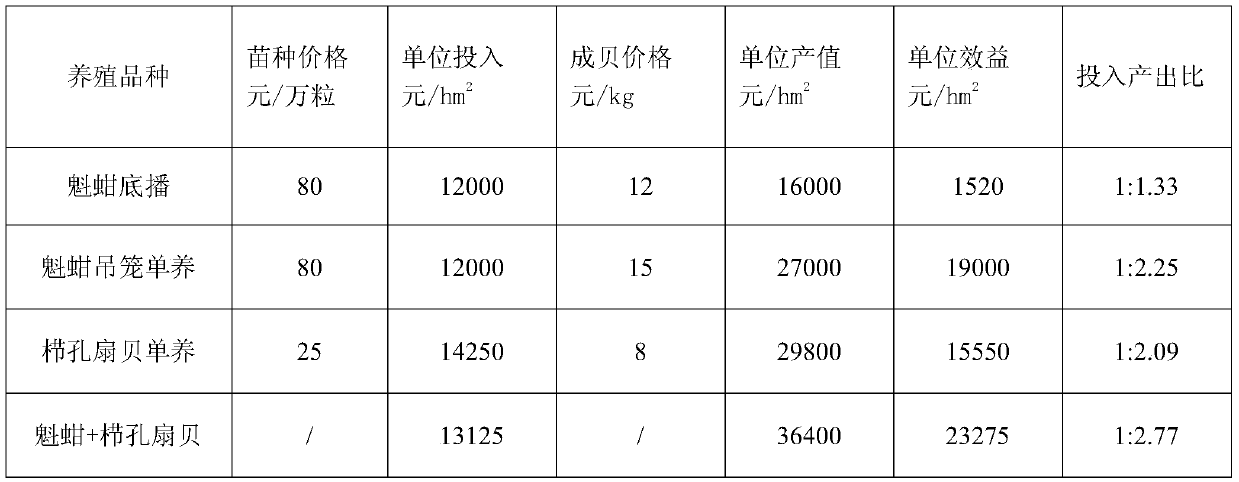Novel shallow sea cage mixed-culture method for scapharca broughtonii and chlamys farreri
The invention relates to a technology for mixed culture of scallops and scallops, which is applied in the field of aquaculture, and can solve the problems of low survival rate, low level of intensive culture, environmental damage, etc., and achieve the effects of reducing the probability of collision, improving the breeding efficiency and improving the survival rate.
- Summary
- Abstract
- Description
- Claims
- Application Information
AI Technical Summary
Problems solved by technology
Method used
Image
Examples
Embodiment 1
[0021] A new method for mixed cultivation of cockles and scallops in shallow sea hanging cages is carried out according to the following cultivation steps:
[0022] 1) Seed selection: Clam cockle seedlings are artificially bred and have a shell length of more than 0.8 cm; Chlamys farreri seedlings are artificially bred or naturally harvested seedlings, and the shell length is more than 0.6 cm;
[0023] 2) Equipment preparation: including temporary cages and growing cages, using scallop cages or re-customizing new cages similar in structure to scallop cages;
[0024] 3) Throwing seedlings: from the end of October to the beginning of November, when the water temperature drops below 15°C, put the clam seedlings and cleft scallop seedlings into temporary cages for overwintering, with a layer capacity of 800 pieces. Stock them in seawater at a depth of 6m, and hang them on floating rafts at intervals of 70-90cm;
[0025] 4) One-time cage inversion: In April of the following year, ...
Embodiment 2
[0030] 1) Seed selection: Clam cockle seedlings are artificially bred and have a shell length of more than 0.8 cm; Chlamys farreri seedlings are artificially bred or naturally harvested seedlings, and the shell length is more than 0.6 cm;
[0031] 2) Equipment preparation: including temporary cages and growing cages, using scallop cages or re-customizing new cages similar in structure to scallop cages;
[0032] 3) Throwing seedlings: from the end of October to the beginning of November, when the water temperature drops below 15°C, put the cockles seedlings and scallop seedlings into temporary cages respectively, and keep them separately for overwintering, with a layer capacity of 1000. Place temporary cages in 8m deep seawater and hang them on floating rafts at intervals of 70-90cm;
[0033] 4) One-time cage inversion: In April of the following year, cage inverting is performed when the water temperature rises above 10°C. Clean up the cockle seedlings and scallop seedlings fr...
Embodiment 3
[0038] 1) Selection of seedlings: the seedlings of cockles are self-propagating seedlings of the Changdao Multiplication Experimental Station. They spawned on June 20, 2013, and were released from the pool on August 10th for temporary cultivation. The temporary cultivation ended on November 15th, with an average size of 0.9 cm, a total of 10 million grains; Chlamys farreri seedlings are self-propagating seedlings from the Long Island Multiplication Experiment Station, spawned on May 11, 2013, were released from the pond on June 15, and were temporarily raised on October 15. The average size 1.1cm, 10 million grains in total;
[0039] 2) Breeding facilities: the culture cages are Chlamys farreri culture cages, which are divided into 2 specifications: temporary cages and grow-out cages;
[0040] 3) Throwing seedlings: On November 8, 2013, when the water temperature dropped below 15°C, put the cockles seedlings and scallop seedlings into temporary cages for overwintering culture,...
PUM
 Login to View More
Login to View More Abstract
Description
Claims
Application Information
 Login to View More
Login to View More - R&D
- Intellectual Property
- Life Sciences
- Materials
- Tech Scout
- Unparalleled Data Quality
- Higher Quality Content
- 60% Fewer Hallucinations
Browse by: Latest US Patents, China's latest patents, Technical Efficacy Thesaurus, Application Domain, Technology Topic, Popular Technical Reports.
© 2025 PatSnap. All rights reserved.Legal|Privacy policy|Modern Slavery Act Transparency Statement|Sitemap|About US| Contact US: help@patsnap.com

